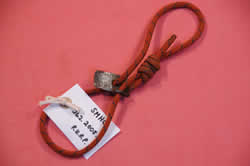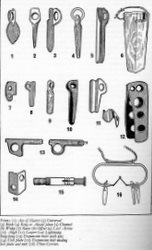
The Scottish Mountain Heritage Collection
Objects Database
R.U.R.P. (Realised Ultimate Reality Piton)
Accession Number
262.2008.1
Object Name
R.U.R.P. (Realised Ultimate Reality Piton)
Created
29/10/2008
Creator
Hermione Cooper
Accession Date
29/10/2008
Brief Description
Realised Ultimate Reality Piton ( R.U.R.P.) P shaped with two holes. Rectangular body with rounded end. Kern mantle sling.
Materials
metal, nylon
Dimensions
4(l) x 2.5(w) x 1.5(d) cms
Number Of Objects
1
Inscription Description
Inscription reads "CML"
Colour
brown
Provenance
The baby of the piton world, Realised Ultimate Reality Pitons were the brainchild of American climbers, Tom Frost and Yvon Chouinard, who used them on the big aid climbs of America; Yosemite in particular. Not sure who donated this one - it's obviously been used by some brave soul!
Like much of British mountaineering terminology weve borrowed the word piton from the continent and in this case it is French; meaning little pig literally. However, to the mountaineering world in general its a metal spike that can be driven into a crack in the rock. They come in all shapes and sizes and have been around for a long, long time; the earliest ones being basically a metal spike driven into the rock for various industrial purposes. Local blacksmiths would have made the first mountaineering versions in the late 1800s. They had fabulous names such as picture hook pitons and Mizzi Langer haken. Because karabiners were yet to be invented the climbing rope was simply hooked over them, or threaded through the attached rope loop or later a metal ring. A blacksmith from the Tyrol area of Austria (he might also have been a mountain guide) called Hans Fiechtl was one of the first to produce a piton with an integral eye around 1930, and this fits nicely with the arrival of karabiners which were being developed around the same time; though Britain was 20 odd years behind the continent in this development there being very few pitons or karabiners around until the ex-WD ones appeared in the army surplus stores after WWII. Early pitons tended to be made from mild steel and some still are; though chrome molybdenum steel is the favoured material in the modern era.
Acquisition Date
29/10/2008
Condition Check Date
28/04/2009
Rules
Spectrum : UK Museum documentation standard, V.3.1 2007
Modified
28/04/2009


